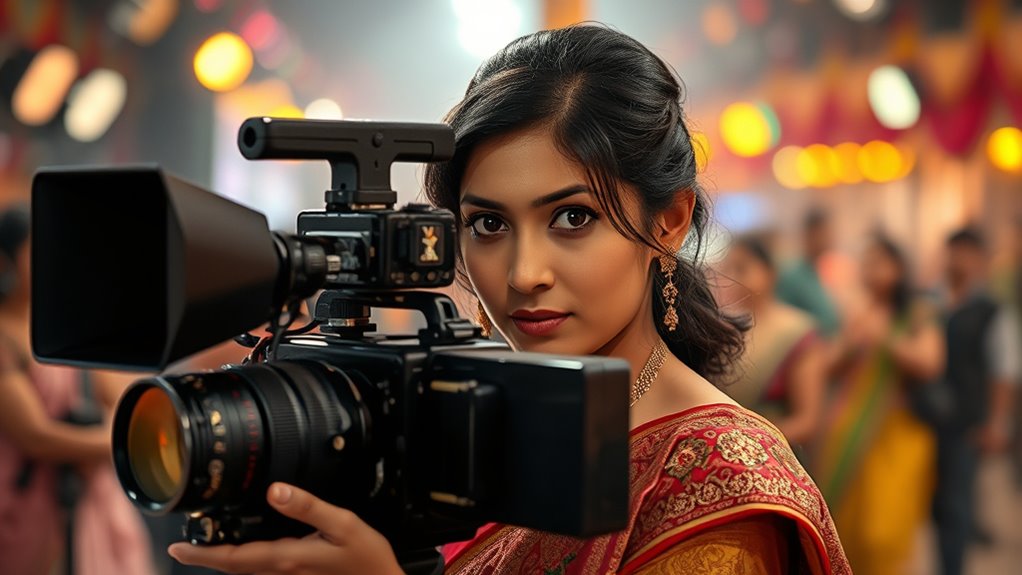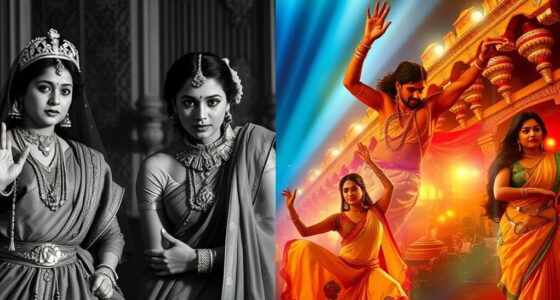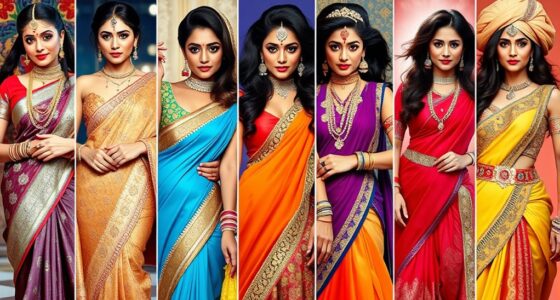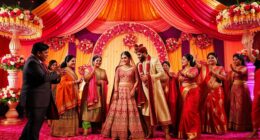Women behind the camera in Bollywood have transformed the industry by challenging norms and creating diverse, powerful stories. Pioneers like Fatma Begum and Devika Rani broke barriers early on, inspiring modern filmmakers to push boundaries. Today, women directors and writers are shaping narratives that highlight women’s independence and challenge stereotypes. Industry support and audience appreciation are growing, signaling a brighter future. Discover how these trailblazing women continue to redefine Bollywood’s cinematic landscape.
Key Takeaways
- Pioneers like Fatma Begum, Jaddanbai, and Devika Rani broke industry barriers as India’s first women directors and producers.
- Contemporary filmmakers such as Zoya Akhtar, Reema Kagti, and Mira Nair are shaping Bollywood with diverse, women-led narratives.
- Women screenwriters like Kanika Dhillon and Alankrita Shrivastava create authentic stories challenging stereotypes.
- Female filmmakers are increasing their presence behind the camera, influencing industry dynamics and inspiring future generations.
- International acclaim and festival recognition highlight the rising influence of Bollywood’s women filmmakers.
The Rise of Women Directors in Bollywood
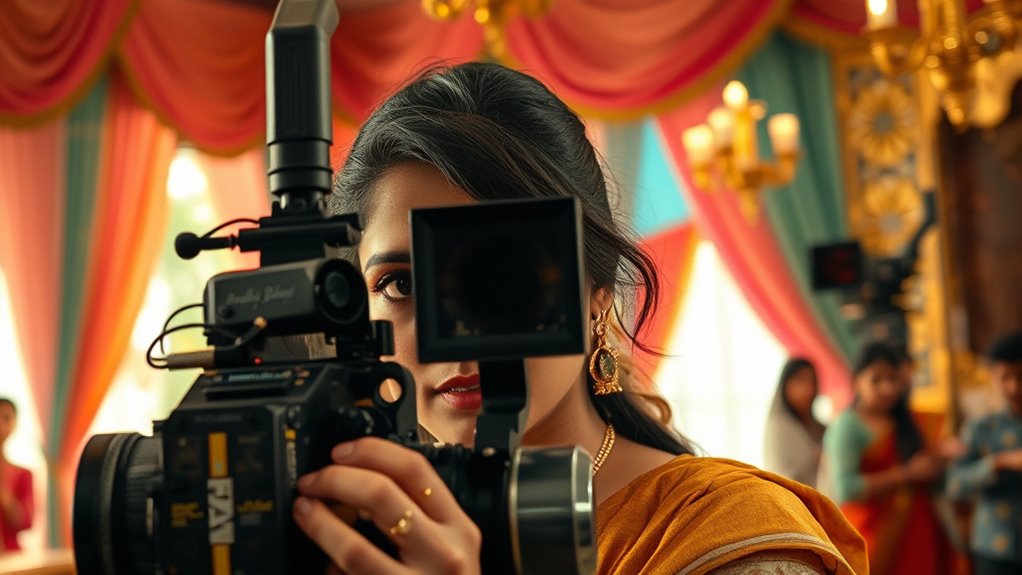
Have you noticed the increasing presence of women directors in Bollywood? Over the past year, their involvement in key production roles has grown from 10% in 2022 to 15% in 2023, signaling progress. Although women still make up only 12% of department heads in Indian films and TV, their influence is rising. At major festivals like Dharamshala International Film Festival, nearly half of the feature films in 2024 were directed by women, showcasing their creative emergence. Female filmmakers are also hiring more women, gradually shifting behind-the-scenes dynamics. Implementing quality assurance practices in filmmaking can help ensure consistent high standards across productions. Recent Achievements of Indian Women Filmmakers in 2024 While challenges remain, these trends demonstrate that women are becoming more prominent, contributing fresh perspectives to Bollywood’s storytelling landscape. Additionally, initiatives promoting women’s representation are helping to create more opportunities and visibility for female directors. The rise of female-led productions reflects a broader shift toward gender diversity in Indian cinema. Recognizing the importance of industry standards can further support the growth of women filmmakers in Bollywood.
Pioneering Films That Challenged Norms
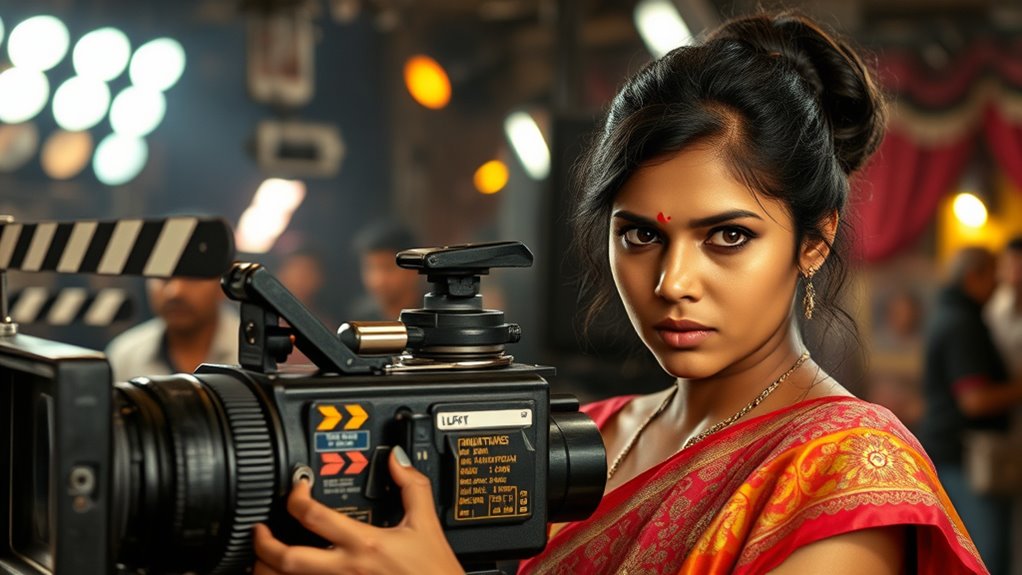
You can see how pioneering films broke gender stereotypes by putting women at the center of powerful stories. These movies challenged industry norms and opened doors for female-led narratives that questioned societal expectations. By pushing boundaries, these filmmakers transformed Indian cinema and inspired future generations. Payal Kapadia’s international recognition signifies a shift towards more diverse and authentic storytelling in Indian cinema. Additionally, the influence of ethical hacking practices has encouraged filmmakers to explore new storytelling techniques that challenge traditional narratives. Incorporating cookie consent management strategies can help creators develop more respectful and transparent engagements with audiences.
Breaking Gender Stereotypes
How did Indian cinema begin to challenge entrenched gender stereotypes? Early Bollywood films often depicted women in traditional, submissive roles, reinforcing societal expectations. But as the feminist movement gained momentum, filmmakers started to push boundaries. In the 1970s to 1990s, the “Angry Young Woman” archetype emerged, giving women more complex, assertive portrayals. Films like “Mirch Masala” (1987) showed women resisting injustice, challenging patriarchal norms directly. These portrayals helped to reshape societal views and open up conversations about gender roles in India. Cinema’s evolving narratives also reflect broader social changes, illustrating how gender stereotypes are being dismantled over time. Today, movies like “Thappad” (2020) and “Paglait” (2021) continue this trend, questioning traditional roles and highlighting women’s independence. Additionally, the increasing presence of women filmmakers has contributed significantly to changing gender narratives, fostering more diverse perspectives. Furthermore, contemporary filmmakers are increasingly exploring feminist themes that challenge traditional stereotypes and promote gender equality. This ongoing transformation in Bollywood underscores the importance of diverse storytelling in shaping societal perceptions of women.
Female-Led Narratives
What makes certain films stand out as trailblazers in challenging societal norms? It’s their bold storytelling and focus on women’s experiences. These films broke barriers by portraying women as complex, independent characters. For instance, early films like *Karma* and *Achhut Kanya* showcased women challenging social expectations, highlighting issues like caste and gender discrimination. Fatma Begum’s *Bulbul-e-Paristan* (1926) was groundbreaking, featuring a female director tackling imaginative themes that defied conventions. Devika Rani’s *Zarina* faced controversy for its kissing scenes, pushing boundaries on morality and female agency. Additionally, the rise of Water Parks in various regions provided family-friendly environments that supported the growth of women filmmakers by offering accessible and inclusive spaces for creative expression. Moreover, the emergence of women-led film festivals played a crucial role in promoting and celebrating female directors and their unique narratives. These pioneering works laid a foundation for modern narratives that focus on personal identity, social justice, and women’s empowerment, inspiring future generations to challenge norms through cinema.
Challenging Industry Norms
From the silent era to the advent of talkies, pioneering women in Indian cinema challenged societal and industry norms by taking on multiple roles behind the camera. Fatma Begum, the first Indian woman director, debuted with *Bulbul-e-Paristan* in 1926, also producing and acting in her films. Jaddanbai founded Sangeet Films and directed *Jeewan Sapna* and *Moti Ka Haar* in the 1930s, establishing her own production house—an unprecedented move in a male-dominated industry. These women often acted, wrote, and produced, showcasing versatility. Their pioneering efforts broke barriers, paving the way for future generations. They challenged social expectations, navigated censorship issues, and explored controversial themes, expanding female agency in storytelling. Their trailblazing work helped reshape industry norms and inspire women filmmakers to come. Additionally, their contributions contributed to the security of eSIM technology by demonstrating how innovative and resilient leadership can push boundaries in traditionally male-dominated fields. Their ability to navigate societal barriers exemplified resilience and expanded opportunities for women in cinema. Moreover, their leadership demonstrated the importance of Cultural Intelligence, enabling them to adapt and thrive amidst shifting cultural landscapes. Recognizing their pioneering spirit has also inspired contemporary female filmmakers to challenge existing industry norms and push creative boundaries. Their innovative storytelling also highlighted the importance of technological adaptation in cinematography, which continues to influence modern filmmaking practices.
Breaking Barriers: Obstacles Faced by Female Filmmakers
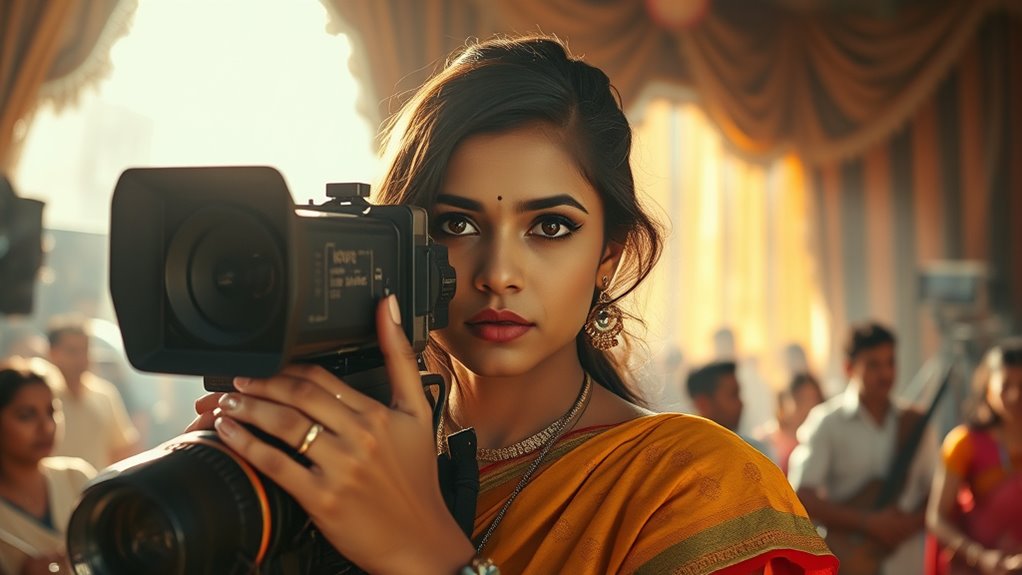
As you explore the challenges female filmmakers face, you’ll notice that industry gender bias often limits their opportunities and recognition. Mentorships are scarce, making it harder to navigate a male-dominated field and build connections. Additionally, safety concerns and social norms can restrict women from pursuing projects or working in certain environments, creating even more barriers to success. Recognizing the importance of comprehensive coverage options can also shed light on how cultural practices influence perceptions and opportunities for women in filmmaking.
Industry Gender Bias
Breaking into the film industry remains a formidable challenge for women due to deeply rooted gender biases. You’ll find that men dominate key roles like directing, writing, and cinematography, holding about 90% of these positions. This male dominance shapes narratives and limits authentic female representation. You may notice that women are often sidelined in decision-making, restricting their influence on storytelling.
Consider these obstacles:
- Limited access to funding, recognition, and distribution for female filmmakers.
- Male-dominated industry networks that hinder collaboration and mentorship.
- Stereotypes that reinforce traditional gender roles, impacting both casting and narrative choices.
These biases create an environment where women’s creative visions are undervalued, making it harder to break through and tell diverse, compelling stories.
Limited Mentorship Opportunities
Limited mentorship opportunities substantially hinder female filmmakers’ ability to advance in the industry. With few women in senior roles, you often find yourself lacking accessible mentors who can guide you through career challenges. The “old boys’ club” culture in Bollywood has historically excluded women from essential networks, leaving you isolated in your growth. Female mentors are scarce and overstretched, unable to support many aspiring filmmakers like you. There are no formal mentorship programs, so guidance depends on sporadic, informal connections. This lack of structured support limits your chances to learn from experienced professionals, develop leadership skills, and build industry relationships. Additionally, the lack of empathy and support in the industry can make navigating these challenges even more daunting, further reducing opportunities for women to succeed. As a result, breaking into leadership roles or gaining industry recognition becomes even more difficult without a solid mentorship foundation.
Safety and Social Norms
Safety concerns on film sets can pose significant challenges for women filmmakers, even though sets are generally considered safe environments. Personal accounts reveal instances where boundaries were crossed, leading to actions like removing problematic individuals. The #MeToo movement exposed widespread sexual harassment, prompting some reforms and heightened awareness. However, many women still feel secure when supported by colleagues and strict protocols. The industry’s handling of harassment cases often falls short, limiting real change.
To navigate these issues, consider these points:
- Establish clear safety protocols and zero-tolerance policies.
- Foster respectful, inclusive work environments with active oversight.
- Support networks and mentorships that empower women and address concerns directly.
These steps help break social norms and safeguard women behind the camera.
Notable Female Directors and Their Impact

Women have made a powerful impact on the world of cinema, transforming storytelling and expanding creative horizons. You’ve seen how directors like Zoya Akhtar push boundaries with films like *Gully Boy* and co-founded Tiger Baby Films, fostering innovative narratives. Reema Kagti’s versatility shines through in movies like *Talaash* and *Gold*, shaping Indian cinema’s landscape. Mira Nair’s films, such as *Monsoon Wedding*, celebrate Indian culture globally, while Meghna Gulzar tackles social issues with *Raazi* and *Chhapaak*. Alankrita Shrivastava explores complex themes, emphasizing women’s roles in society. These women have not only achieved international recognition but also inspired future generations, proving that female filmmakers are essential in redefining cinema’s future. Their impact continues to influence storytelling worldwide.
The Role of Female Screenwriters in Shaping Narratives

You can see how female screenwriters are reshaping Bollywood by creating more authentic and diverse stories about women. Their scripts challenge stereotypes, showing women as complex, independent characters with desires and contradictions. This shift not only broadens narratives but also influences how audiences perceive women’s roles on screen.
Crafting Authentic Female Stories
Have female screenwriters truly transformed Bollywood storytelling? Absolutely. They’re crafting authentic female stories that reflect real women’s lives, moving beyond patriarchal stereotypes. Their work brings fresh perspectives and nuanced portrayals, resonating deeply with audiences. As you explore their impact, consider these key contributions:
- Representation: Women writers are increasingly recognized for telling stories centered on women’s experiences.
- Authenticity: They focus on portraying women’s complexities, not just traditional heroines.
- Industry Shift: Their success encourages more diverse, inclusive narratives, transforming Bollywood’s storytelling landscape.
These writers, like Kanika Dhillon and Alankrita Shrivastava, are leading a cultural shift—making stories more relatable and empowering women’s voices in cinema.
Challenging Stereotypes Through Scripts
Female screenwriters are actively reshaping Bollywood narratives by challenging long-standing stereotypes and introducing fresh perspectives. With more women stepping into writing roles, scripts now reflect the female gaze and authentic experiences, reducing clichéd portrayals of women. As more female voices join writers’ rooms, traditional stereotypes are questioned and rewritten, leading to diverse themes and complex characters. The rise of OTT platforms has created opportunities for women to showcase their storytelling skills and gain visibility. Despite facing systemic barriers, such as undervaluation and limited recognition, these writers are breaking through and influencing industry norms. Their work not only diversifies stories but also pushes the industry to reconsider outdated tropes, making way for more genuine, nuanced portrayals of women on screen.
Female-Led Productions and Their Cultural Significance
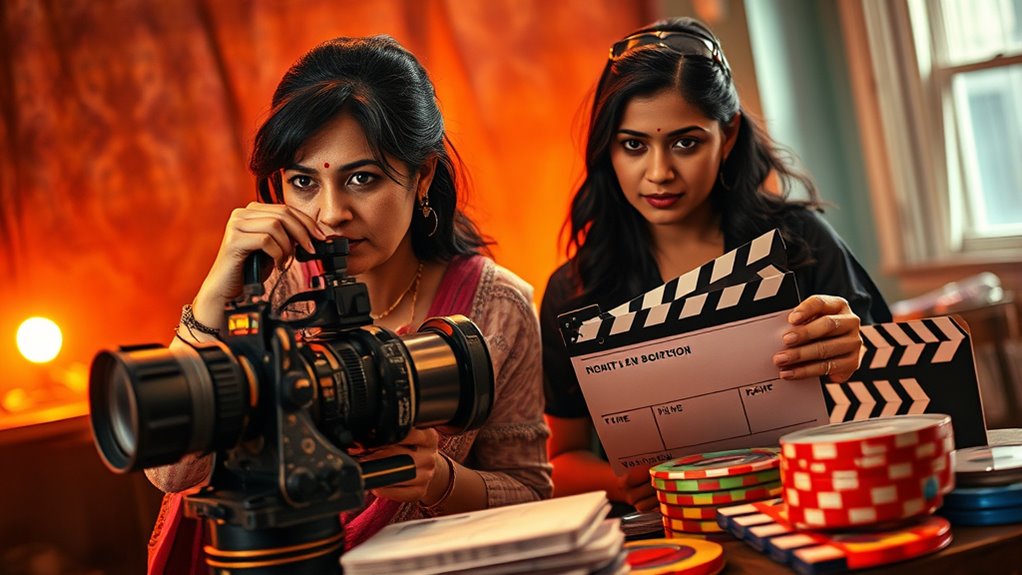
How are female-led productions reshaping the cultural landscape of cinema today? They’re bringing fresh perspectives, more diverse stories, and stronger female characters to the forefront. This shift is reflected in the rising number of women in key production roles—15% in Indian films in 2023, up from 10% in 2022. These productions challenge traditional gender roles and promote realistic, complex portrayals of women. They also gain international recognition, like the Malayalam film winning at Cannes. As a result, audiences are embracing more diverse representations of strength and heroism.
Here are three ways they make an impact:
- Introducing diverse, authentic storytelling.
- Challenging stereotypes through empowered female protagonists.
- Influencing societal norms and perceptions.
Mentorship and Networking: Building Support Systems

As more women lead productions and challenge traditional storytelling norms, creating strong support systems becomes crucial for sustained progress. Mentorship offers essential career guidance, helping you navigate industry challenges and develop strategic plans. It also opens doors to networking opportunities with established professionals, indispensable for collaborations and project growth. Through mentorship, you can sharpen your skills with expert feedback, boosting your confidence and leadership potential. Participating in industry events, joining professional organizations like Women in Film, or engaging in online forums expands your connections. Mentorship programs, such as those by Women in Film India or MAMI Mumbai, provide personalized support and industry insight. Building these networks strengthens your presence in Bollywood, empowering you to tell diverse stories and shape the future of Indian cinema.
Audience Reception and Changing Perceptions
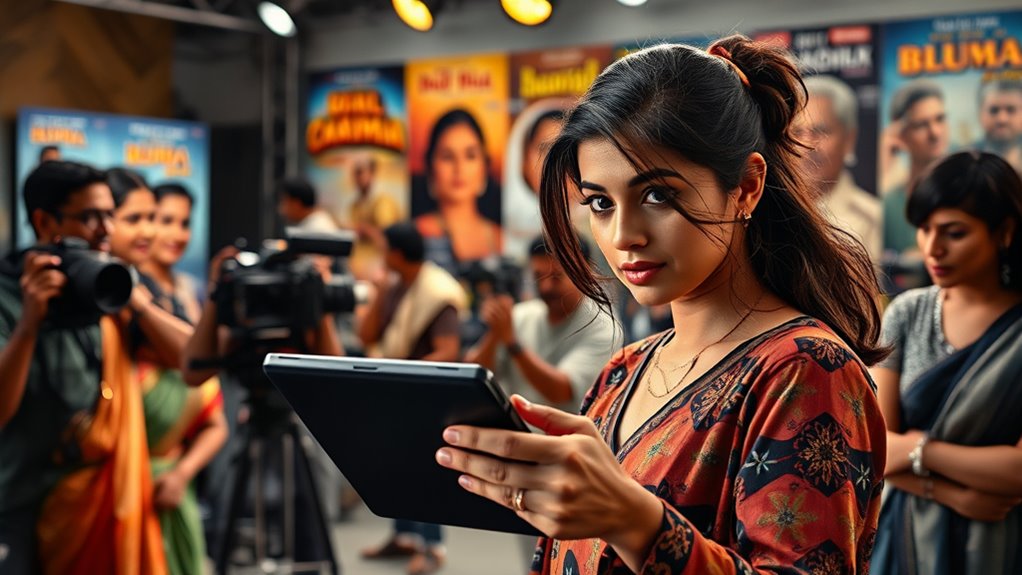
Have perceptions about women in action roles truly shifted? Audience reception shows a positive trend, recognizing female action heroes as empowering and relatable. Still, many critique the limited screen time and impact compared to male leads. You’ll notice a growing interest in female-led stories, reflecting changing tastes and a desire for diverse narratives. These films challenge traditional gender norms, contributing to broader cultural shifts. To understand this shift, consider:
- The increasing market potential for female-led action films, signaling audience acceptance.
- The rise of films like *Ek Ladki Ko Dekha To Aisa Laga* that showcase women’s power and agency.
- The overall perception of women in these roles as resilient and capable, indicating evolving societal attitudes.
These changes point to a more inclusive cinematic landscape, but challenges remain.
Future Trends and Emerging Female Filmmakers
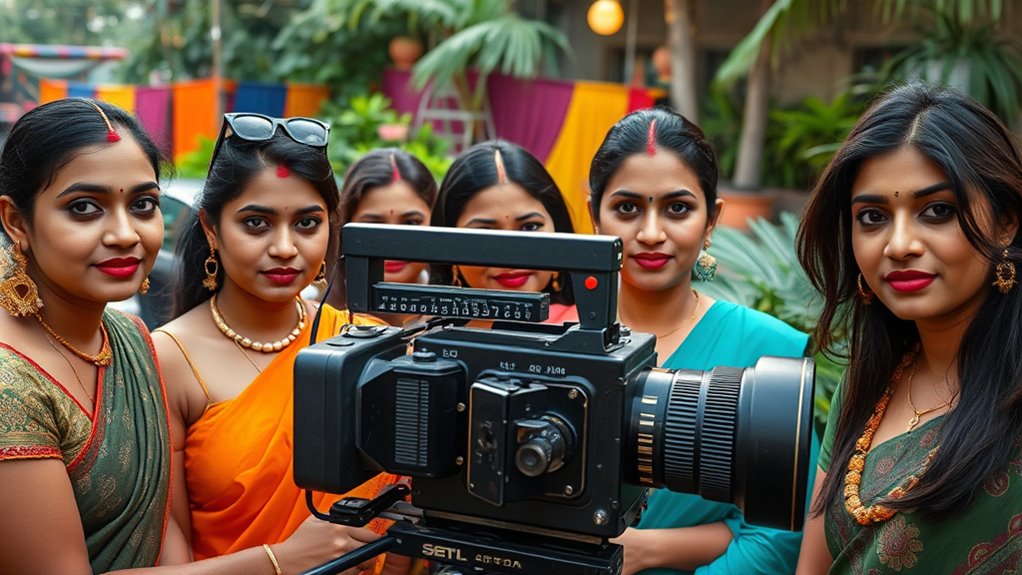
The industry is experiencing a notable shift toward embracing fresh directorial talent, with 2025 seeing a surge in Bollywood debutants who bring new perspectives and storytelling styles. Female directors like Shazia Iqbal and Shauna Gautam are leading exciting first projects across genres, from hard-hitting dramas to big commercial hits. These newcomers introduce innovative narrative techniques, modernizing traditional storytelling. Industry support is growing, with established names backing emerging talent and festivals spotlighting women filmmakers. International recognition for Indian women at top festivals like Cannes and Sundance highlights their rising influence. As more women craft authentic stories centered on female experiences, Bollywood is evolving to include diverse voices and bold themes. Digital platforms and industry initiatives further amplify these emerging filmmakers, shaping a dynamic, inclusive future.
How Female Filmmakers Are Transforming Bollywood

Female filmmakers are actively reshaping Bollywood by taking on more prominent roles behind the scenes. They’re increasing their presence in key production positions, with 15% of Indian movies in 2024 hiring women, up from 10% in 2022. Their influence is evident in the rise of female-led stories, challenging traditional male-dominated narratives. Here’s how they’re transforming Bollywood:
- Expanding roles: Women are now more often writers and directors, bringing diverse perspectives.
- Changing portrayals: Films showcase women as complex, multidimensional characters, moving beyond passive roles.
- Global recognition: Films by women earn international acclaim, shifting industry perceptions and inspiring more investment.
This shift enhances storytelling, reflecting real women’s experiences and broadening Bollywood’s creative horizon.
Frequently Asked Questions
How Do Female Filmmakers Influence Bollywood’S Portrayal of Women?
You see how female filmmakers influence Bollywood’s portrayal of women by challenging stereotypes and highlighting diverse, realistic stories. They create strong, multidimensional characters that reflect modern societal shifts. Their work promotes empowerment, gender equality, and resistance to traditional norms. By choosing unique themes and narratives, you notice that these filmmakers inspire change, broaden perspectives, and contribute to a more inclusive industry that resonates globally, encouraging audiences to see women as complex, powerful individuals.
What Initiatives Support Women Directors in Bollywood?
Think of initiatives supporting women directors as a rising tide lifting all boats. You’ll see recognition through awards like The Hollywood Reporter’s Power List, and festivals such as MAMI actively promote female-led films, increasing representation to 25% in 2024. Mentorship programs and industry advocacy challenge stereotypes, helping women break barriers. These efforts create a more inclusive environment where women’s stories flourish, inspiring change across Bollywood and beyond.
How Has Audience Reception Evolved Towards Female-Led Films?
You see that audience reception is changing significantly. Now, you’re more likely to support female-led films because themes of empowerment and real-life stories resonate deeply. You’re interested in diverse genres and appreciate nuanced portrayals of women. This shift means you’re more accepting and enthusiastic to see strong female protagonists on screen, helping to boost their box office success and encouraging filmmakers to create more meaningful, relatable stories centered around women.
What Challenges Remain for Women Pursuing Directing Roles?
Imagine a path once overgrown with thorns, now slowly clearing. You still face challenges pursuing directing roles—scarcity of opportunities, societal stereotypes, and industry biases blocking your way. Limited funding and resources act like unseen barriers, while cultural norms whisper doubts. Despite progress, you must navigate these obstacles, build networks, and challenge stereotypes. Your perseverance is essential in transforming this landscape into one where women can confidently lead the camera’s lens.
How Can Aspiring Women Filmmakers Break Into Bollywood?
To break into Bollywood, you should actively participate in women-focused film labs, workshops, and grant programs that boost your skills and help build your network. Create compelling short films or documentaries that showcase your unique perspective, and submit them to festivals for recognition. Collaborate with female mentors or production houses, stay aware of audience trends favoring female-led stories, and leverage industry events to gain visibility and credibility.
Conclusion
As you watch these women behind the camera, remember they’re the guiding stars illuminating Bollywood’s path forward. Their courage plants seeds of change, growing into a vibrant forest of diverse stories and voices. Like the eternal flame, their passion keeps burning bright, inspiring others to follow. Together, they’re transforming the industry into a canvas where every hue and shade can shine, proving that true change begins when you dare to light your own way.
